Health Catalyst Bundle
Can Health Catalyst Revolutionize Healthcare with Data?
Health Catalyst, a frontrunner in healthcare analytics, is on a mission to transform the industry. Founded in 2008, the company leverages data and analytics to improve clinical, financial, and operational outcomes for healthcare providers. Their Health Catalyst SWOT Analysis provides a deep dive into their strengths and weaknesses.
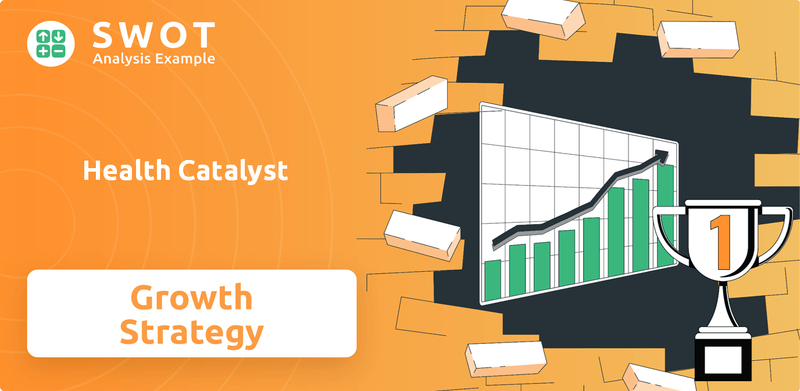
This exploration of Health Catalyst's growth strategy will examine its recent acquisitions, including Upfront Healthcare and Intraprise Health, and its transition to the Ignite platform. We'll analyze how these moves, along with continuous innovation in healthcare technology, are shaping the company's future prospects. Furthermore, we'll delve into the financial outlook and potential challenges, providing a comprehensive view of Health Catalyst's journey in the dynamic healthcare analytics market, focusing on data-driven decisions and value-based care solutions.
How Is Health Catalyst Expanding Its Reach?
Health Catalyst's growth strategy is primarily focused on expanding its offerings and market reach. This involves strategic acquisitions, platform enhancements, and exploring new market opportunities. The company's approach aims to improve service delivery and operational efficiency for its clients.
A significant part of Health Catalyst's expansion involves migrating clients to its new Ignite platform. This initiative is designed to provide a more modular and cost-efficient solution. Furthermore, the company is actively pursuing partnerships and exploring expansion into adjacent and international markets to drive future growth.
The company's inorganic growth strategy is evident through its acquisitions. Health Catalyst completed three acquisitions in 2024 and one in early 2025, demonstrating a commitment to expanding its capabilities and market presence. These acquisitions are strategically aligned to enhance its service offerings and strengthen its position in the healthcare analytics market.
In January 2025, Health Catalyst acquired Upfront Healthcare for $86 million. This acquisition is aimed at integrating personalized patient activation and engagement capabilities. This move is expected to enhance the patient experience and complement existing platforms.
In November 2024, Health Catalyst acquired Intraprise Health for approximately $43 million. This acquisition strengthens Health Catalyst's capabilities in cybersecurity risk management and information security. This is a critical need for healthcare organizations.
In June 2024, Health Catalyst acquired Carevive Systems, an oncology-focused health technology company. This acquisition enhances Health Catalyst's ability to support cancer care improvement. It also provides insights into patient-reported outcomes.
A key strategic initiative is the migration of Health Catalyst's platform clients to its new Ignite platform. The company aims to have this migration two-thirds complete by the end of 2025. The migration is expected to be largely finalized by mid-2026.
Health Catalyst is focused on integrating recent acquisitions and improving profitability in 2025. The company plans to add approximately 40 net new platform clients in 2025, with 10 already added in Q1 2025. Expansion into adjacent and international markets may also be part of the future growth strategy.
- The Ignite platform is designed to improve service delivery and enhance operational efficiency.
- Partnerships, such as with Microsoft, are expanding the reach of Ignite modules.
- The company's growth strategy includes a focus on data-driven decisions and innovation in healthcare technology.
- Health Catalyst is addressing the challenges and opportunities in the healthcare analytics market.
Health Catalyst SWOT Analysis
- Complete SWOT Breakdown
- Fully Customizable
- Editable in Excel & Word
- Professional Formatting
- Investor-Ready Format
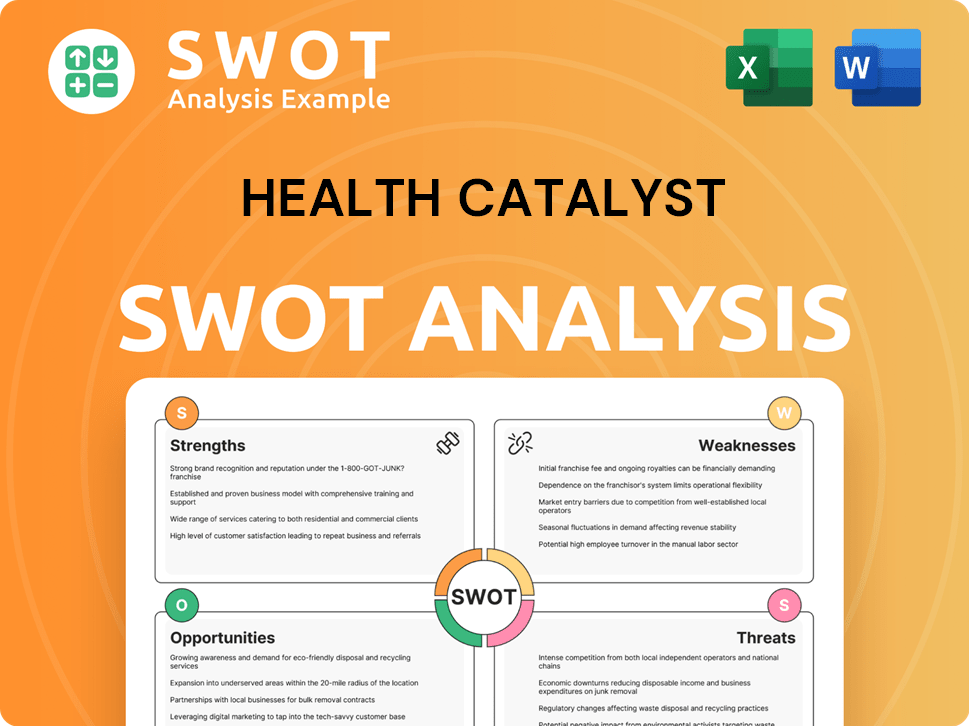
How Does Health Catalyst Invest in Innovation?
Health Catalyst leverages technology and innovation to drive sustained growth, with a strong focus on its new Health Catalyst Ignite platform and the strategic integration of artificial intelligence (AI). The company's approach to innovation is designed to meet the evolving needs of healthcare organizations. This involves developing solutions that improve operational efficiency, enhance patient care, and support data-driven decision-making.
The company's commitment to innovation is evident in its investments in AI and machine learning. Health Catalyst aims to enhance its product offerings through these technologies, creating new opportunities for growth and differentiation. This focus aligns with the broader trend of healthcare organizations seeking advanced analytics and AI solutions to improve outcomes and reduce costs.
The Health Catalyst Ignite platform, launched in May 2024, is a next-generation healthcare data and analytics ecosystem designed to transform the end-user experience and reduce costs and time-to-value for data management and governance tasks. This cloud-based platform is a cornerstone of Health Catalyst's Growth Strategy, facilitating a shift from retrospective analysis to predictive insights.
The Ignite platform integrates best-in-class technologies, healthcare-specific data models, and self-service tools. It is powered by data from over 100 million patient records. This platform is designed to streamline data management and governance, reducing both costs and the time it takes to achieve value.
Health Catalyst is strategically integrating AI to enhance its product offerings. The company's focus on AI is underscored by the appointment of Dr. Daniel Samarov as Chief AI Officer in February 2025. AI is being leveraged for cybersecurity purposes to respond to offensive attacks.
The HealthCare.ai solution has been instrumental in helping clients like the Innovative Healthcare Collaborative of Indiana (IHCI) optimize patient care strategies. This solution has contributed to reducing readmissions and lowering per-member-per-month spending.
Health Catalyst expanded its partnership with Microsoft, making certain Ignite modules, including healthcare.ai, transactable on the Microsoft Azure marketplace. This collaboration enhances the accessibility and reach of Health Catalyst's solutions.
Health Catalyst leaders anticipate that 2025 will be a significant year for the maturation of AI adoption in healthcare. The focus is on practical use cases such as decision support and automating administrative tasks to minimize dependency on high-cost labor.
Health Catalyst's solutions support value-based care models, helping healthcare providers improve patient outcomes while managing costs. This aligns with the industry's shift towards outcomes-based reimbursement.
Health Catalyst's Growth Strategy is heavily reliant on technological advancements and strategic partnerships. The company continues to invest in Healthcare Analytics and data-driven solutions to meet the evolving needs of the healthcare industry. For further insights into the company's strategies, consider reading the Marketing Strategy of Health Catalyst.
- AI and Machine Learning: Integrating AI to enhance product offerings and improve operational efficiency.
- Data Platform: Utilizing a cloud-based platform to provide predictive insights and streamline data management.
- Strategic Partnerships: Expanding collaborations with companies like Microsoft to broaden market reach.
- Value-Based Care Solutions: Supporting healthcare providers in improving patient outcomes and managing costs.
- Cybersecurity: Leveraging AI for cybersecurity purposes to respond to offensive attacks.
Health Catalyst PESTLE Analysis
- Covers All 6 PESTLE Categories
- No Research Needed – Save Hours of Work
- Built by Experts, Trusted by Consultants
- Instant Download, Ready to Use
- 100% Editable, Fully Customizable
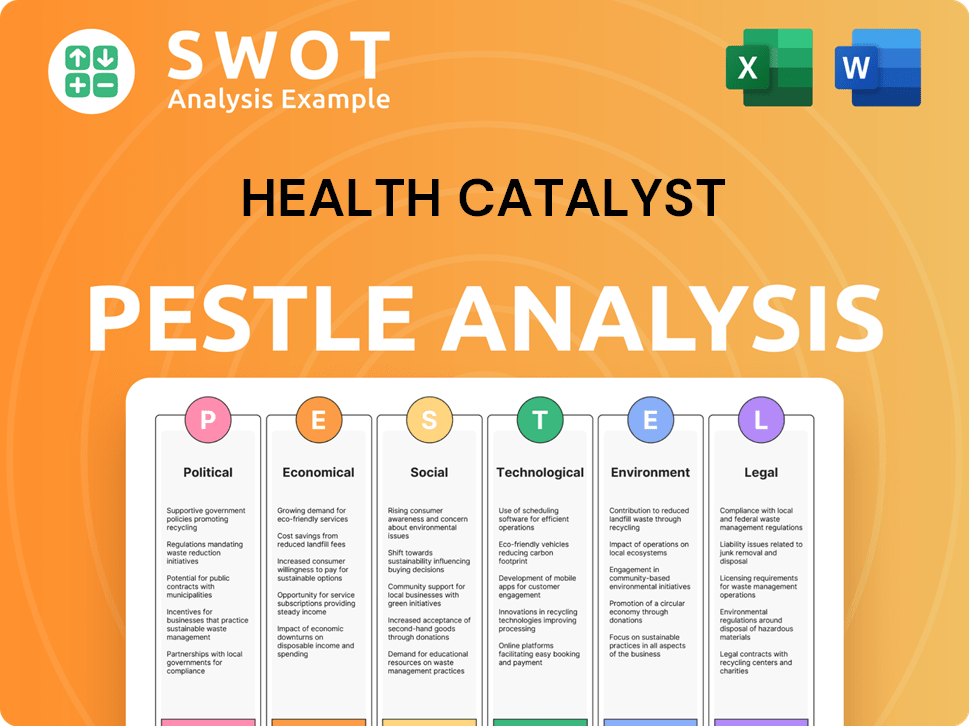
What Is Health Catalyst’s Growth Forecast?
The financial outlook for Health Catalyst in 2025 indicates a strategic focus on profitable expansion and enhanced operational efficiency. The company is leveraging its position in the healthcare analytics market to drive sustainable growth. This approach is crucial for maintaining a competitive edge and capitalizing on the increasing demand for data-driven solutions in healthcare.
In 2024, the company demonstrated solid financial performance, with total revenue reaching $370 million, reflecting a 4% year-over-year increase. Adjusted EBITDA surged by 137% to $26 million. This performance underscores the company's ability to manage costs and improve profitability. The growth trajectory is expected to continue, supported by strategic initiatives and market opportunities.
Health Catalyst anticipates total revenue of approximately $335 million in 2025. Technology revenue is projected to grow by about 13% year-over-year to $220 million. The company's adjusted EBITDA is expected to reach roughly $41 million for the full year 2025, showcasing a commitment to improving profitability. These projections highlight the company's strategic focus on financial health and sustainable growth within the healthcare technology sector.
In 2024, Health Catalyst reported total revenue of $370 million, marking a 4% year-over-year growth. Adjusted EBITDA increased by 137% to $26 million, demonstrating significant improvement in profitability. Technology revenue reached $195 million, also growing by 4% year-over-year. This financial performance sets a strong foundation for future growth.
For 2025, Health Catalyst projects total revenue of approximately $335 million. Technology revenue is anticipated to grow by about 13% year-over-year to $220 million. These projections reflect the company's strategic focus on expanding its technology solutions within the healthcare sector. The company's outlook is positive, driven by its strategic initiatives and market opportunities.
The company expects its adjusted EBITDA to reach approximately $41 million for the full year 2025. This significant increase highlights the company's focus on enhancing profitability and operational efficiency. The projected growth in adjusted EBITDA demonstrates Health Catalyst's ability to manage costs and improve its financial performance.
In Q1 2025, Health Catalyst reported total revenue of $79.4 million, exceeding its guidance. Adjusted EBITDA for Q1 2025 was $6.3 million, also outperforming expectations. This strong start to the year sets a positive tone for the company's financial performance in 2025. The company's ability to exceed expectations in Q1 indicates strong market demand.
Health Catalyst is focusing on key strategic initiatives to drive future growth and profitability. These initiatives include the transition to the Ignite platform, integration of recent acquisitions, and a focus on improving operational efficiency. These strategies are essential for maintaining a competitive edge and capitalizing on opportunities within the healthcare technology market. The company's strategic approach supports its long-term financial goals.
- Transition to the Ignite platform is expected to impact technology gross margins.
- Prioritizing integration and profitability from recent acquisitions in 2025.
- Focus on improving operational efficiency and managing costs.
- No immediate plans for further M&A activity.
Health Catalyst Business Model Canvas
- Complete 9-Block Business Model Canvas
- Effortlessly Communicate Your Business Strategy
- Investor-Ready BMC Format
- 100% Editable and Customizable
- Clear and Structured Layout
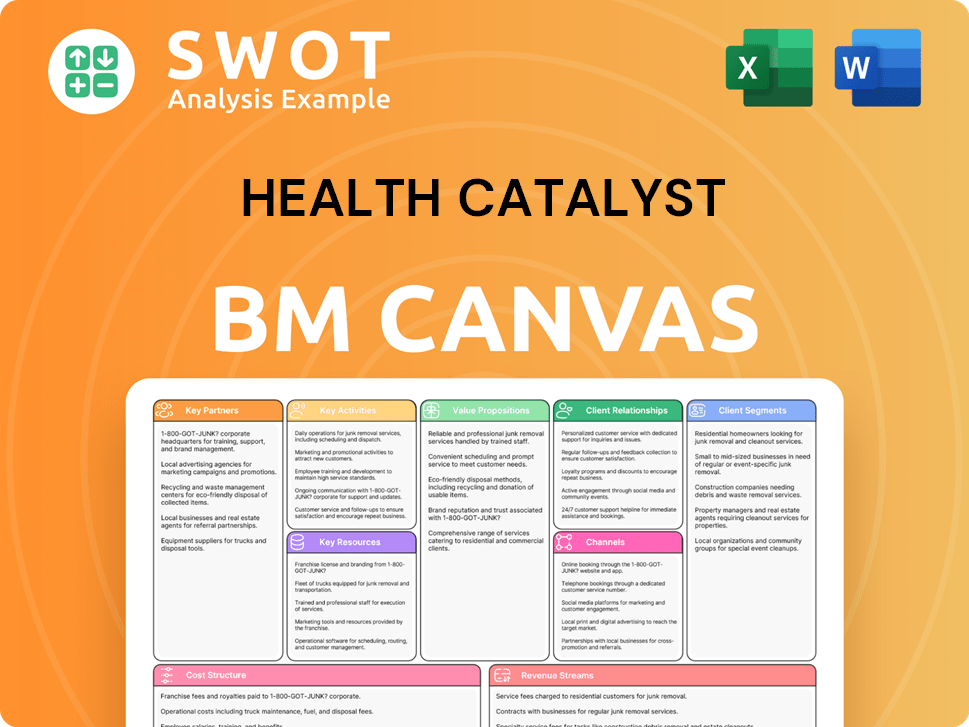
What Risks Could Slow Health Catalyst’s Growth?
The path of Health Catalyst towards its Growth Strategy and realizing its Future Prospects is fraught with potential obstacles. The company navigates a highly competitive landscape within the healthcare industry, facing challenges from larger and better-resourced entities. Moreover, rapid technological advancements and shifting client needs introduce additional layers of complexity.
Technological disruption, especially in areas like AI and machine learning, presents a significant risk. The company's reliance on these technologies introduces development challenges, regulatory uncertainties, and potential third-party claims. Client satisfaction with its cloud-based data platform and services is also critical. Furthermore, macroeconomic factors and data security threats continually pose challenges.
The company's financial health is sensitive to macroeconomic conditions. High inflation, rising interest rates, and market volatility could negatively affect its business. Additionally, data security risks, including cyberattacks and data breaches, are a constant threat. The company's dependence on third-party data sources and computing infrastructure providers also poses risks of service disruptions and increased costs.
Health Catalyst operates in a fiercely competitive market. It competes with established players and other emerging companies. The company must continually innovate to maintain its market position and attract new clients.
Rapid advancements in technology, particularly in AI and machine learning, can pose risks. The company must adapt quickly to maintain its competitive edge. Failure to do so could lead to obsolescence of its solutions.
The company's financial performance is heavily reliant on client retention and expansion. Losing key clients or failing to secure new contracts can significantly impact revenue. The ability to renew contracts at favorable terms is also crucial.
Macroeconomic conditions, such as inflation and interest rate hikes, can affect the company's business. Economic downturns can lead to reduced healthcare spending. These conditions can indirectly influence the demand for Healthcare Analytics solutions.
As a provider of Healthcare Technology solutions, the company handles sensitive patient data. Data breaches or cyberattacks can damage its reputation and lead to financial liabilities. Robust data security measures are critical.
Changes in healthcare regulations can impact the company's operations and solutions. Compliance with evolving regulations requires constant adaptation and investment. The company needs to maintain a strong understanding of the regulatory landscape.
The Health Catalyst faces intense competition from both established healthcare IT vendors and emerging Healthcare Analytics firms. The market is characterized by rapid innovation and the potential for disruptive technologies. The company must continuously invest in research and development to stay ahead. The competitive landscape requires strategic agility and a focus on differentiation.
Operational risks include challenges related to client onboarding, platform integration, and service delivery. Financial risks encompass fluctuations in revenue, the ability to manage costs, and the impact of economic downturns. The company's financial performance is also affected by its ability to retain existing clients and secure new contracts. Health Catalyst must maintain strong financial discipline to navigate these challenges.
Technological risks stem from the rapid evolution of AI, machine learning, and cloud computing. The company must ensure its solutions remain current and relevant. Data security and privacy are critical concerns, with the potential for breaches and regulatory penalties. The company's reliance on third-party data sources and infrastructure introduces additional risks.
Changes in healthcare regulations, such as those related to data privacy and interoperability, can significantly impact the company. Compliance with evolving standards requires ongoing investment and adaptation. The company must stay informed about regulatory changes and proactively adjust its strategies. The regulatory environment adds complexity to Data-Driven Decisions.
For further insight, understanding the Mission, Vision & Core Values of Health Catalyst can provide a deeper understanding of the company's strategic direction and priorities.
Health Catalyst Porter's Five Forces Analysis
- Covers All 5 Competitive Forces in Detail
- Structured for Consultants, Students, and Founders
- 100% Editable in Microsoft Word & Excel
- Instant Digital Download – Use Immediately
- Compatible with Mac & PC – Fully Unlocked
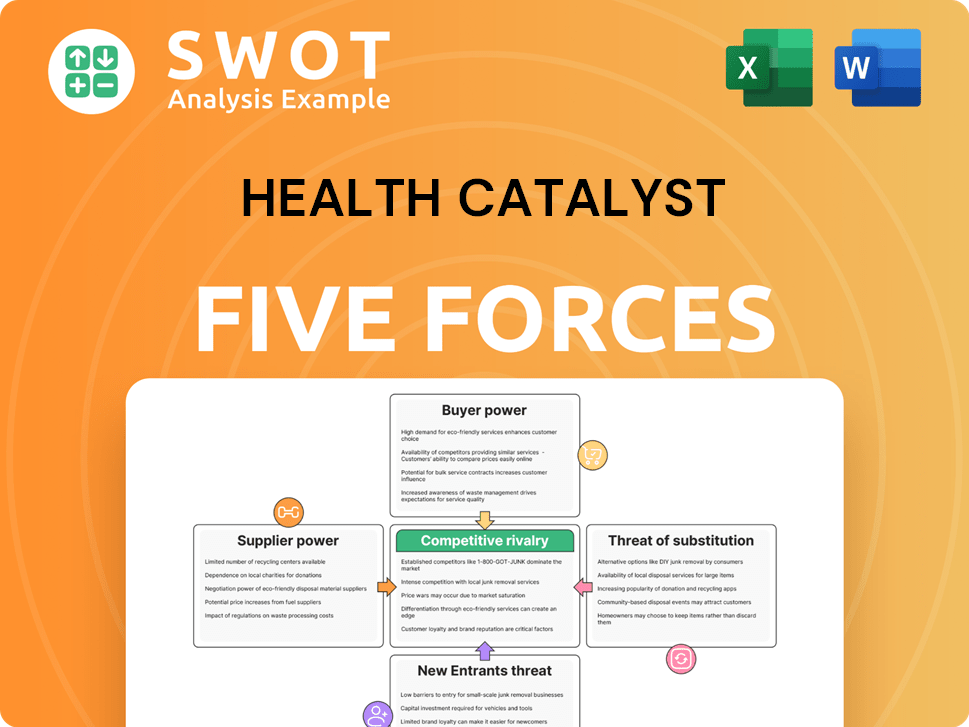
Related Blogs
- What are Mission Vision & Core Values of Health Catalyst Company?
- What is Competitive Landscape of Health Catalyst Company?
- How Does Health Catalyst Company Work?
- What is Sales and Marketing Strategy of Health Catalyst Company?
- What is Brief History of Health Catalyst Company?
- Who Owns Health Catalyst Company?
- What is Customer Demographics and Target Market of Health Catalyst Company?
Disclaimer
All information, articles, and product details provided on this website are for general informational and educational purposes only. We do not claim any ownership over, nor do we intend to infringe upon, any trademarks, copyrights, logos, brand names, or other intellectual property mentioned or depicted on this site. Such intellectual property remains the property of its respective owners, and any references here are made solely for identification or informational purposes, without implying any affiliation, endorsement, or partnership.
We make no representations or warranties, express or implied, regarding the accuracy, completeness, or suitability of any content or products presented. Nothing on this website should be construed as legal, tax, investment, financial, medical, or other professional advice. In addition, no part of this site—including articles or product references—constitutes a solicitation, recommendation, endorsement, advertisement, or offer to buy or sell any securities, franchises, or other financial instruments, particularly in jurisdictions where such activity would be unlawful.
All content is of a general nature and may not address the specific circumstances of any individual or entity. It is not a substitute for professional advice or services. Any actions you take based on the information provided here are strictly at your own risk. You accept full responsibility for any decisions or outcomes arising from your use of this website and agree to release us from any liability in connection with your use of, or reliance upon, the content or products found herein.